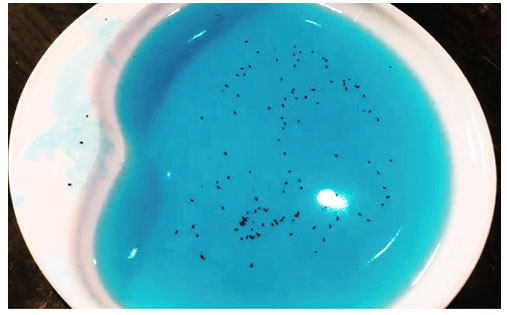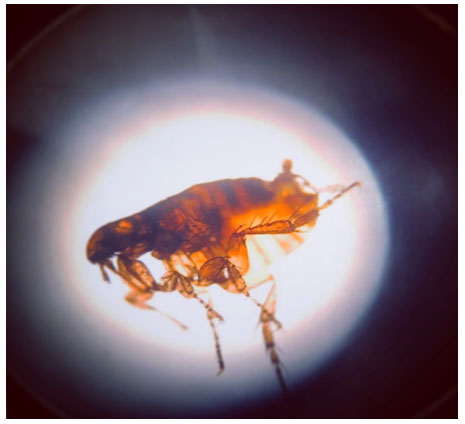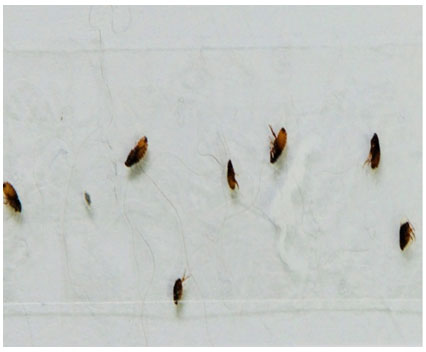1Northern Trans-Ural State Agricultural University St. Republic 7, Tyumen, 625003 Russia
2Department of Non-Communicable Diseases of Farm Animals, Northern Trans-Ural State
Agricultural University St. Republic 7, Tyumen, 625003 Russia
Corresponding author email: russia@prescopus.com
Article Publishing History
Received: 15/10/2021
Accepted After Revision: 29/12/2021
From time immemorial people began to domesticate wild animals and throughout many generations, they are kept by people genetically isolated from external pathogens. In the prevailing era, every pet owner is trying to breed and protect his animal from contagious and noncontagious diseases. Having said that, lack and inadequacy of knowledge and mass media on simple preventive measures results in the widespread occurrence of infectious and invasive diseases, including flea, Ctenocephalides felis infestation among dogs as well as cats. The present paper primarily attempts to present the results of therapeutic efficiency of Komfortis, Foresto, and Fitoelita medical agents used during flea infestation among domestic cats.
In order to meet the purpose of the study, research was carried out within the framework of study and analysis of the epizootic state of invasive diseases of agricultural and unproductive animals, bees, and birds. Studies of changes in the species composition, and bioecological patterns of the development cycle of parasites under shifting boundaries of their ranges were also done. For the study, the animals were divided into three groups of 10 animals each. Standard clinical and hematological research methods were used during the study. Blood sampling included three stages: before insecticide treatment, the intermediate interval of 15 days, and the final stage. Based on the results obtained, it was found that Komfortis and Foresto have 100% therapeutic efficacy at all stages of flea development and possess a long-lasting action duringa flea infestation. The morphological blood analysisshowed that the proposed medical agents have no toxic orsideeffects.
Aphaniptera, Cats, Ctenocephalides Felis, Flea Infestations, Insecticides
Kruglov D. S, Stolbova O. A. Insecticidal Efficacy of Medicines During Cat Flea Infestations in Tyumen. Biosc.Biotech.Res.Comm. 2021;14(4)
Kruglov D. S, Stolbova O. A. Insecticidal Efficacy of Medicines During Cat Flea Infestations in Tyumen. Biosc.Biotech.Res.Comm. 2021;14(4). Available from: <a href=”https://bit.ly/3339Dbo“>https://bit.ly/3339Dbo</a>
Copyright © Kruglov et al., This is an open access article distributed under the terms of the Creative Commons Attribution License (CC-BY) https://creativecommns.org/licenses/by/4.0/, which permits unrestricted use distribution and reproduction in any medium, provide the original author and source are credited.
INTRODUCTION
Flea, Ctenocephalides felis infestation of domestic cats is one of the urgent problems which is being studied by modern veterinary science, but despite the achieved success of parasitic pharmacy in their elimination, fleas are widely spread and represent a danger to cats, dogs, and other domestic carnivorous animals kept in close contact with human beings, the owners and those contacting them, (Arkhipovet al., 2001; Roslavtseva, 2011; Berezina, 2015; Nikonovet al., 2017; Stolbovaet al., 2018; Stolbovа,2018; Stolbova&Skosyrskikh, 2020). To prevent the distribution of flea infestations it is necessary to account for ensuring continuous epizootic control over timely medical and preventive measures to eliminate the focus of disease, (Glazunov, 2014; Berezina, 2015;Domatsky, 2016; Cooper et al., 2020).
Today the veterinary science employs various anti-parasitic agents that are different in their forms, chemical composition, mode of administration, and price. However, despite the variety of insecticidal agents created to fight against flea infestations, some current flea species are resistant to some classes of insecticides containing two and more active drug substances, (Lyutikova and Arkhipov, 2008; Stepanov et al., 2014; Glazunova and Tkachyova, 2017; Stolbovа, 2019; Packianathan et al., 2020). The resistance level may be high to exclude the possibility of any further use of either medical agent. There are known cases when the resistance of parasitic arthropods is developed even at the stage of testing a new medicine prior to its industrial output, (Udavliyev et al., 2012; Gerke, 2013; KruglovandStolbova, 2017; Stolbova et al., 2018; Stolbovа, 2018; Stolbova, 2020; Tielemans et al., 2021).
In this regard,the efforts of experts are aimed not only atthe creation of new medicinal compounds with a different mode of action but also atthe search of such insecticide strategy, which could prevent the formation of resistant types of parasitic arthropods. Thus, it is critical to develop new medical agents, mainly complex ones containing several active drug substances. This combination is advantageous since various active substances cause a synergistic impact on all stages of flea development.
MATERIAL AND METHODS
The study was performed during 2014-2020 at a vivarium of the Institute of Biotechnology and Veterinary Medicine of the Northern Trans-Ural State Agricultural University Russia. The experimental part was conducted at the laboratories of the All-Russian Research Institute of Veterinary Entomology and Arachnology – branch of Tyumen Research Center, SB RAS, and the veterinary clinics of Tyumen. This research was conducted within the framework of the topic № 296-2021-0018 -Thirty animals were picked for the study (different breed, age, nutritional state) thus forming three equal groups (n=10).Komfortis was applied to the first test group, Foresto – to the second, and Fitoelita shampoo – to the third control group.
Komfortis is an insecticide released as pill for oral use, it contains spinosad – 53.33%, is active towards fleas such as Ctenocephides felis parasitizing dogs and cats. The mechanism of action involves the activation of n-cholinergic receptors of parasitic arthropods, causing nervous strain, muscle cramps, tremors, and paralysis leading to the death of insects (Instruction for medical use of Komfortis).
RESULTS AND DISCUSSION
During the study, it was noted that Komfortis and Foresto have high insecticidal effectsreaching 98-100%. The insecticide efficacy was considered within a month, every 5 days from the moment of applying for the medicines.It shall be noted that the number of dead images was sharply increasing from the first to the tenth day of the study in test groups. The maximum mortality rate was on the 5th day of observations, where for the first group this made – 34.28%, and for the second – 29.30%. During the following observation,thenumber of fleas in test groups was reduced. The therapeutic efficacyof applied medical agentsmade 100% in the first group on the 25th day of observation and in the second group on the 30th day. The smallest number of parasites per one infected specimen was observed with Komfortis– 45.8.
The analysis of the insecticidal activity of the control group showed that the efficacyof the medical agent was indicated only at the time of drug administration,during theinterimperiods the numberof fleas was minimum, the maximum mortality rate was observed on the 20th day,and made 18.24%. The highest invasiveness per one specimenof the control group made 102.5, which indicates the progressive growth of fleas at all control points. All results are shown in Table 1.
Table 1. Insecticide efficacy during cats FLEA Infestation in Tyumen
| Assessment period | First test group Komfortis agent (n=10) | Second test group Foresto collar (n=10) | Control group
Fitoelita shampoo (n=10) |
|||
| Number of detected fleas | % | Number of detected fleas | % | Number of detected fleas | % | |
| 1st day | 144 | 31.44 ± 0.67 | 121 | 25.69 ± 0.71 | 157 | 15.31 ± 0.76 |
| 5th day | 157 | 34.28 ± 0.58 | 138 | 29.30 ± 0.69 | 104 | 10.15 ± 0.54 |
| 10th day | 112 | 24.45 ± 0.52 | 124 | 26.33 ± 0.52 | 161 | 15.71 ± 0.48 |
| 15th day | 29 | 8.52 ± 0.42 | 68 | 12.31± 0.37 | 130 | 12.68 ± 0.65 |
| 20th day | 6 | 1.31 ± 0.34 | 39 | 8.28 ± 0.29 | 187 | 18.24 ± 0.44 |
| 25th day | 0 | 0 ± 0.25 | 11 | 2.34 ± 0.21 | 133 | 12.97 ± 0.76 |
| 30th day | 0 | 0 ± 0.28 | 0 | 0 ± 0.17 | 153 | 14.93 ± 0.51 |
| Total | 458 | 471 | 1025 | |||
| Infection intensity | 45.8 | 47.1 | 102.5 | |||
The study of the therapeutic efficacy of Komfortis, Foresto, and Fitoelita during flea infestation of cats did not reveal any negative impact on their organism, there were no toxicoses and gastrointestinal upsets.The hematologic study showed that during the primary blood sampling a minor increase of white blood cells was noted among all groups of animals (Stolbovа, 2018; Stolbova & Skosyrskikh, 2020). After the use of insecticidal agents, the follow-up tests were performed at interim intervals. The first and the second groups are characterized by the decrease of indicators to the minimum, while the control group – by the increase in leukocytes to 7.98 ± 0.41%, eosinophils to 2.68 ± 0.46%, other indicators remained unchanged.
At the final stage of blood sampling from the groups exposed to Komfortis and Foresto the animals were fully recovered, the blood values fell within the physiological range, the indicators of the control group did not change drastically from primary tests at the beginning of therapy. All results are shown in Table 2. The hematologic blood changes of cats with flea infestations demonstrate that at different invasiveness the values do not change considerably from physiological range. Thus, the hematologic study made it possible to confirm that the treatment with such medical agents does not exert a pathogenic impact on blood values, which fall within the physiological range.
Table 2. The main hematologic changes of blood during cat’s flea infestation in Tyumen
| Indicator | Leucocytes,
109/l |
Eosinocytes, % | Band neutrophils, % | Segmented neutrophils, % | Lymphocytes, % | Monocytes, % |
| Blood test at the beginning of study | ||||||
| First group
Komfortis |
7.61 ± 0.41 | 2.38 ± 0.45 | 2.41 ± 0.38 | 37.68 ± 1.26 | 31.87 ± 0.29 | 2.13 ± 0.33 |
| Second group
Foresto |
7.64 ±0.44 | 2.42 ± 0.38 | 2.40 ± 0.21 | 37.62 ± 1.62 | 31.81 ± 0.25 | 2.15 ± 0.39 |
| Control group
Fitoelita |
7.55 ±0.39 | 2.44 ± 0.42 | 2.40 ± 0.21 | 37.65 ± 1.64 | 31.86 ± 0.28 | 2.12 ± 0.38 |
| Interim blood test on the 15th day | ||||||
| First group
Komfortis |
6.81 ± 0.42 | 1.86 ± 0.52 | 1.38± 0.33 | 36.22 ± 1.26 | 27. 45 ± 0.34 | 1.61 ± 0.35 |
| Second group
Foresto |
6.93 ±0.38 | 1.97 ± 0.49 | 1.42± 0.36 | 36.28 ± 1.28 | 28.16 ± 0.32 | 1.89 ± 0.29 |
| Control group
Fitoelita |
7.98 ± 0.41 | 2.68 ± 0.46 | 2.14± 0.31 | 37.15 ± 1.12 | 31.64 ± 1.12 | 1.64 ± 0.32 |
| Final blood test on the 30th day | ||||||
| First group
Komfortis |
6.24 ± 0.51 | 0.82 ± 0.34 | 0.28± 0.12 | 35.46 ± 0.66 | 26.14 ± 0.29 | 1.25 ± 0.31 |
| Second group
Foresto |
6.28 ±0.49 | 0.86 ± 0.42 | 0.34± 0.15 | 35.51 ± 0.69 | 26.17 ± 0.26 | 1.54 ± 0.28 |
| Control group
Fitoelita |
8.14 ±0.53 | 2.74 ± 0.38 | 2.15± 0.22 | 37.02 ± 1.16 | 31.42 ± 1.24 | 2.49 ± 0.29 |
Foresto is an insect-acaricidal collar, it contains imidacloprid – 1.25 g and flumethrin – 0.56 g. The mechanism of imidacloprid action is based on the interaction with acetylcholine receptors of ectoparasites. It causes neurotransmission disorder resulting in complete paralysis leading to the death of ectoparasites. Flumethrin is a pyrethroid insecticide affecting voltage-sensitive sodium channels, it blocks nerve conduction resulting in spasm causing motor reflexes of arthropods leading to death (Instruction for medical use of Foresto). Fitoelita is an insecticidal shampoo, it contains permethrin – 0.3%, blocks neurotransmission of peripheral nerves ganglion leading to death through paralysis of flea adult and larval phases (Instruction for medical use of Fitoelita).
The following special methods were used: hair combing (to define the number of alive and dead fleas) (Fig. 1), flea counting in Dawn Professional Dawn solution (Fig. 2), microscopic study (to define flea viability) (Fig. 3), hair print using acetate bands (to detect fleas and products of their activity) (Fig. 4). The obtained results were processed statistically via Statistica Ultimate Academic Bundle (Stolbovа, 2018; Stolbova, 2020; Tielemans et al., 2021).
Figure 1: Collection of fleas and eggs during combing

Figure 2: Ctenocephalides felis in Professional Dawn solution after combing

Figure 3: Ctenocephalides felis under microscopic vision

Figure 4: Hair print with Ctenocephalides felis

The dosage of Komfortis pills was selected individually taking into account animal weight prior to treatment. Komfortis was applied at a dose of 50 mg/kg. The insect-acaricidal Foresto collar was used as per instructions for cats (38 cm). The medical agents were applied once only for test groups. The insecticidal Fitoelita shampoo was used at the rate of 1 ml/kg, its application was repeated after 10 days as per the manufacture’s recommendations. The efficiency of applied medical agents during flea infestations of domestic animals was assessed following the results of clinical, hematologic, and special trials, and estimation of infestation intensity.
The blood tests were analyzed via the Abacus Junior 5 (Vet), sampling was done on the first day, further periods were broken into interim stages of 15 days. The flea infestation was validated using the special study of hair and skin cover of all groups of animals before treatment and after the application of insecticidal medicines.
CONCLUSION
The efficacy of using such insecticidal medical agents as Komfortis and Foresto collars as the therapy of cat flea infestations makes 100% effective. The application of such insecticides allows facilitating and reducing the length of treatment of pets.Further observation of patients after treatment did not reveal any reinfestation cases, which indicates its long-term action and serves as an excellent preventive method.
REFERENCES
Arkhipov I A, Borzunov E N, Shaykin V I (2001). Parasitic animals transferred to a person from dogs and cats, I.A. Arkhipov,Proceedings of the IX International Congress on Diseases of Small Pets. – M. pp. 230-231.
Berezina E S (2015).Population structure, features of morphology and behavior and role of domestic dogs and cats in the distribution of natural and focal infections in Russia: extended abstract of Cand. Sci. Dissertation. Omsk. pp. 40.
Cooper, A. R., Nixon, E. M. I. L. Y., Rose Vineer, H., Abdullah, S., Newbury, H. A. N. N. A. H., & Wall, R. I. C. H. A. R. D. (2020). Fleas infesting cats and dogs in Great Britain: spatial distribution of infestation risk and its relation to treatment. Medical and Veterinary Entomology, 34(4), 452-458.https://doi.org/10.1111/mve.12462.
Domatsky V N (2016).Therapy and prevention of parasitosis among dogs and cats, Achievements of modern science, V. 9, No. 11, pp. 93-96.
Gerke A N (2013).Diagnostic approach and therapy during noninflammatory alopecia of cats, VetPharma, No. 5-6, pp. 42-59.
Glazunova L A, Tkachyova Yu A (2017). Comparative efficiency of agents during flea infestation of dogs and cats, The Veterinarian, No. 5, pp. 44-48.
Kruglov D S, Stolbova O A (2017).Ctenocephalides among dogs and cats in Tyumen, Bulletin of the State Agricultural University of the Northern Trans-Ural region, No. 2, pp. 67-70.
Lyutikova I A, Arkhipov I A (2008). Methodical recommendations on therapy and prevention of ctenocephalides among dogs and cats, Russian parasitological journal, No. 2, pp. 117-122.
Nikonov A A, Siben A N, Pipchenko E V (2017). Seasonal features of aphaniptera among dogs and cats in Tyumen, In the collection: Modern scientific and practical solutions in agrarian and industrial complex. Proceedings of the international scientific and practical conference. pp. 352-356.
Packianathan, R., Pittorino, M., Hodge, A., Bruellke, N., & Graham, K (2020). Safety and efficacy of a new spot-on formulation of selamectin plus sarolaner in the treatment and control of naturally occurring flea infestations in cats presented as veterinary patients in Australia. Parasites & vectors, 13(1), 1-7.https://doi.org/10.1186/s13071-020-04099-x.
Roslavtseva S A (2011).Epidemiological value of fleas and disinsection against them, Medical alphabet, vol. 1, vol. 5, pp. 58-63.
Stepanov V A, Arisov M V, Smirnova E S (2014). Toxicological assessment and insect-acaricidal efficiency of agents ‘RolfClub 3D spray for dogs’ and ‘RolfClub 3D spray for cats, Russian parasitological journal, vol. 3 (29), pp. 112-117.
Stolbova O A, Skosyrskikh L N(2020).Сhange of immunological blood indicators during follicular cattle mange. Eurasian Journal of Biosciences. V.14. №1. pp.1055-1058.
Stolbova O A(2020).Distribution of Bovine Demodicosis in the Forest-Steppe Zone of the Northern Trans-Urals. HELIX. V.10. № 5. pp.44-47.
Stolbovа O A (2019).Parasitic activity of demodex ticks among cattle. Indo American Journal of Pharmaceutical Sciences. Vol.6. P.13337-13341.
Stolbova O A, Glazunov Yu V, Skosyrskikh L N (2018).Ticks-parasites o f dogs in Northern Trans-Urals, Indo American Journal of Pharmaceutical Sciences, vol. 5 (3), рр. 1675-1682.
Stolbovа O A (2018).Acaricide activity of “abifipr” medicine at dog demodicosis, Indo American Journal of Pharmaceutical Sciences. IAJPS, vol. 05 (07), рр. 6594-6597.
Tielemans, E., Buellet, P., Young, D., Viljoen, A., Liebenberg, J., & Prullage, J. (2021). Efficacy of a novel topical combination of esafoxolaner, eprinomectin and praziquantel against adult cat flea Ctenocephalides felis and flea egg production in cats. Parasite, 28.https://dx.doi.org/10.1051%2Fparasite%2F2021017.
Udavliyev D I, Shuteeva E N, Kochanova S V, Panfilov A V (2012). Fight against ectoparasites of pets, Problem of veterinary sanitation, hygiene and ecology, vol. 1, pp. 24-29.
Yu.V. Glazunov, O A(2014).Stolbova Efficiency of insect-acaricidal agents in deratization of objects of veterinary supervision, Messenger of veterinary science. No. 2 (69), pp. 26-29.


